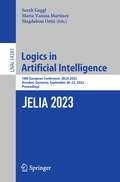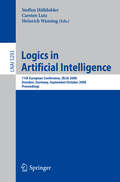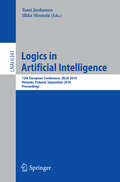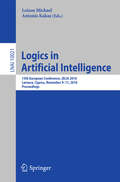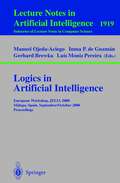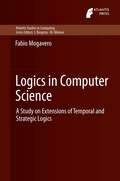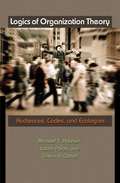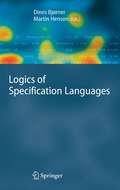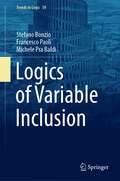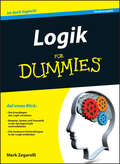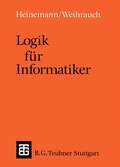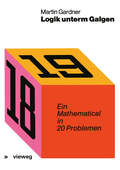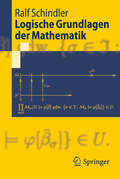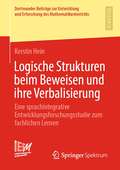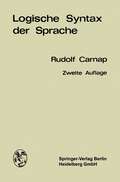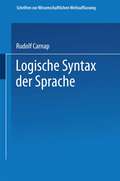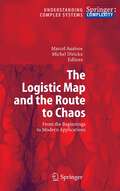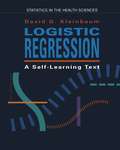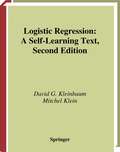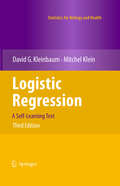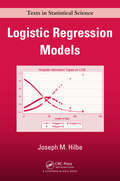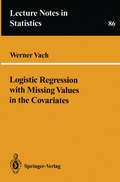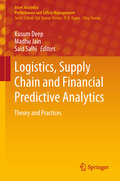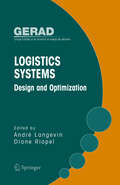- Table View
- List View
Logics in Artificial Intelligence: 18th European Conference, JELIA 2023, Dresden, Germany, September 20–22, 2023, Proceedings (Lecture Notes in Computer Science #14281)
by Sarah Gaggl Maria Vanina Martinez Magdalena OrtizThis book constitutes proceedings of the 18th European Conference on Logics in Artificial Intelligence, JELIA 2023, held in Dresden, Germany, in September 2023.The 41 full papers and 11 short papers included in this volume were carefully reviewed and selected from 111 submissions. The accepted papers span a number of areas within Logics in AI, including: argumentation; belief revision; reasoning about actions, causality, and change; constraint satisfaction; description logics and ontological reasoning; non-classical logics; and logic programming (answer set programming).
Logics in Artificial Intelligence: 11th European Conference, JELIA 2008, Dresden, Germany, September 28-October 1, 2008. Proceedings (Lecture Notes in Computer Science #5293)
by Steffen Hölldobler Carsten Lutz Heinrich WansingThis book constitutes the refereed proceedings of the 11th European Conference on Logics in Artificial Intelligence, JELIA 2008, held in Dresden, Germany, Liverpool, in September/October 2008. The 32 revised full papers presented together with 2 invited talks were carefully reviewed and selected from 98 submissions. The papers cover a broad range of topics including belief revision, description logics, non-monotonic reasoning, multi-agent systems, probabilistic logic, and temporal logic.
Logics in Artificial Intelligence: 12th European Conference, JELIA 2010, Helsinki, Finland, September 13-15, 2010, Proceedings (Lecture Notes in Computer Science #6341)
by Tomi Janhunen Ilkka NiemeläLogics in Artificial Intelligence: 15th European Conference, JELIA 2016, Larnaca, Cyprus, November 9-11, 2016, Proceedings (Lecture Notes in Computer Science #10021)
by Loizos Michael Antonis KakasThis book constitutes the proceedings of the 15th European Conference on Logics in Artificial Intelligence, JELIA 2016, held in Larnaca, Cyprus, in November 2015. The 32 full papers and 10 short papers included in this volume were carefully reviewed and selected from 88 submissions. The accepted papers span a number of areas within Logics in AI, including: belief revision, answer set programming, argumentation, probabilistic reasoning, handling inconsistencies, temporal logics and planning, description logics, and decidability and complexity results.
Logics in Artificial Intelligence: European Workshop, JELIA 2000 Malaga, Spain, September 29 - October 2, 2000 Proceedings (Lecture Notes in Computer Science #1919)
by Manuel Ojeda-Aciego Inma P. De Guzman Gerhard Brewka Luis M. PereiraLogics in Computer Science: A Study on Extensions of Temporal and Strategic Logics (Atlantis Studies in Computing #3)
by Fabio MogaveroIn this monograph we introduce and examine four new temporal logic formalisms that can be used as specification languages for the automated verification of the reliability of hardware and software designs with respect to a desired behavior. The work is organized in two parts. In the first part two logics for computations, the graded computation tree logic and the computation tree logic with minimal model quantifiers are discussed. These have proved to be useful in describing correct executions of monolithic closed systems. The second part focuses on logics for strategies, strategy logic and memoryful alternating-time temporal logic, which have been successfully applied to formalize several properties of interactive plays in multi-entities systems modeled as multi-agent games.
Logics of Organization Theory: Audiences, Codes, and Ecologies
by Michael T. Hannan László Pólos Glenn R. CarrollBuilding theories of organizations is challenging: theories are partial and "folk" categories are fuzzy. The commonly used tools--first-order logic and its foundational set theory--are ill-suited for handling these complications. Here, three leading authorities rethink organization theory. Logics of Organization Theory sets forth and applies a new language for theory building based on a nonmonotonic logic and fuzzy set theory. In doing so, not only does it mark a major advance in organizational theory, but it also draws lessons for theory building elsewhere in the social sciences. Organizational research typically analyzes organizations in categories such as "bank," "hospital," or "university." These categories have been treated as crisp analytical constructs designed by researchers. But sociologists increasingly view categories as constructed by audiences. This book builds on cognitive psychology and anthropology to develop an audience-based theory of organizational categories. It applies this framework and the new language of theory building to organizational ecology. It reconstructs and integrates four central theory fragments, and in so doing reveals unexpected connections and new insights.
Logics of Specification Languages (Monographs in Theoretical Computer Science. An EATCS Series)
by Dines Bjørner Martin C. HensonThis book presents comprehensive studies on nine specification languages and their logics of reasoning. The editors and authors are authorities on these specification languages and their application. In a unique feature, the book closes with short commentaries on the specification languages written by researchers closely associated with their original development. The book contains extensive references and pointers to future developments.
Logics of Variable Inclusion (Trends in Logic #59)
by Stefano Bonzio Francesco Paoli Michele Pra BaldiThis monograph shows that, through a recourse to the concepts and methods of abstract algebraic logic, the algebraic theory of regular varieties and the concept of analyticity in formal logic can profitably interact. By extending the technique of Plonka sums from algebras to logical matrices, the authors investigate the different classes of models for logics of variable inclusion and they shed new light into their formal properties.The book opens with the historical origins of logics of variable inclusion and on their philosophical motivations. It includes the basics of the algebraic theory of regular varieties and the construction of Plonka sums over semilattice direct systems of algebra. The core of the book is devoted to an abstract definition of logics of left and right variable inclusion, respectively, and the authors study their semantics using the construction of Plonka sums of matrix models. The authors also cover Paraconsistent Weak Kleene logic and survey its abstract algebraic logical properties. This book is of interest to scholars of formal logic.
Logik für Dummies (Für Dummies)
by Mark ZegarelliLogik ist die Basis der Wissenschaft, aber auch eine Brücke zwischen Wissenschaft und Alltag, denn die Grundlagen sind einfach logisch. Doch so einfach sie auf den ersten Blick scheint, so anspruchsvoll ist sie im Detail. "Logik kompakt für Dummies" führt Sie systematisch und so einfach wie möglich in dieses Teilgebiet von Mathematik und Philosophie ein. Dabei arbeitet Mark Zegarelli mit anschaulichen Beispielen und schafft es so, dieses abstrakte Thema nicht nur verständlich zu erklären, sondern auch Wert und Nutzen der Logik aufzuzeigen.
Logik für Informatiker: Eine Einführung (Leitfäden und Monographien der Informatik)
by Bernhard Heinemann KLAUS WEHIRAUCHLogische Grundlagen der Mathematik (Springer-Lehrbuch)
by Ralf SchindlerDer Autor vermittelt logisches Grundwissen, fundamentale Beweisprinzipien und Methoden der Mathematik. Dabei geht er u. a. folgenden Fragen nach: Was unterscheidet endliche von unendlichen Mengen? Wie lassen sich die ganzen, rationalen und reellen Zahlen aus den natürlichen Zahlen konstruieren? Welche grundlegenden topologischen Eigenschaften besitzt die Menge der reellen Zahlen? Lassen sich die natürlichen oder reellen Zahlen vollständig axiomatisch beschreiben? Pflichtlektüre für alle Studierenden der Mathematik, Physik und Informatik.
Logische Strukturen beim Beweisen und ihre Verbalisierung: Eine sprachintegrative Entwicklungsforschungsstudie zum fachlichen Lernen (Dortmunder Beiträge zur Entwicklung und Erforschung des Mathematikunterrichts #46)
by Kerstin HeinBeweisen ist eine zentrale Tätigkeit innerhalb der universitären Mathematik. Im Mathematikunterricht gibt es jedoch zumeist wenig Lerngelegenheiten, um Beweisen zu erlernen. Insbesondere Lehr-Lern-Arrangements zur Förderung des Beweisens unter Berücksichtigung der sprachlichen Anforderungen fehlen. Aus diesem Grund stellt Kerstin Hein ein theoretisch fundiertes und empirisch erprobtes Lehr-Lern-Arrangement zur Förderung des Beweisens vor. Sie untersucht dafür logische Strukturen und die darauf bezogenen Beweistätigkeiten unter Berücksichtigung der Sprache, die bisher selten als Lerngegenstand betrachtet wurden. Die Autorin rekonstruiert Wirkungsweisen von graphischen und sprachlichen Unterstützungsformaten und die individuellen Lernwege bei der Bearbeitung des entwickelten Lehr-Lern-Arrangements.
Logische Syntax der Sprache (Schriften zur wissenschaftlichen Weltauffassung #8)
by Rudolf Carnap Philipp Frank Moritz SchlickDieser Buchtitel ist Teil des Digitalisierungsprojekts Springer Book Archives mit Publikationen, die seit den Anfängen des Verlags von 1842 erschienen sind. Der Verlag stellt mit diesem Archiv Quellen für die historische wie auch die disziplingeschichtliche Forschung zur Verfügung, die jeweils im historischen Kontext betrachtet werden müssen. Dieser Titel erschien in der Zeit vor 1945 und wird daher in seiner zeittypischen politisch-ideologischen Ausrichtung vom Verlag nicht beworben.
The Logistic Map and the Route to Chaos: From the Beginnings to Modern Applications (Understanding Complex Systems)
by Marcel Ausloos Michel DirickxPierre-Francois Verhulst, with his seminal work using the logistic map to describe population growth and saturation, paved the way for the many applications of this tool in modern mathematics, physics, chemistry, biology, economics and sociology. Indeed nowadays the logistic map is considered a useful and paradigmatic showcase for the route leading to chaos. This volume gathers contributions from some of the leading specialists in the field to present a state-of-the art view of the many ramifications of the developments initiated by Verhulst over a century ago.
Logistic Regression: A Self-Learning Text (Statistics for Biology and Health)
by David G. KleinbaumThis text on logistic regression methods contains the following eight chapters: 1 Introduction to Logistic Regression 2 Important Special Cases of the Logistic Model 3 Computing the Odds Ratio in Logistic Regression 4 Maximum Likelihood Techniques: An Overview 5 Statistical Inferences Using Maximum Likelihood Techniques 6 Modeling Strategy Guidelines 7 Modeling Strategy for Assessing Interaction and Confounding 8 Analysis of Matched Data Using Logistic Regression Each chapter contains a presentation of its topic in "lecture-book" format together with objectives, an outline, key formulae, practice exercises, and a test. The "lecture-book" has a sequence of illustrations and formulae in the left column of each page and a script in the right column. This format allows you to read the script in conjunction with the illustrations and formulae that high light the main points, formulae, or examples being presented. The reader mayaiso purchase directly from the author audio-cassette tapes of each chapter. If you purchase the tapes, you may use the tape with the illustrations and formulae, ignoring the script. The use of the audiotape with the illustrations and formulae is intended to be similar to a lecture. An audio cassette player is the only equipment required. Tapes may be obtained by writing or calling the author at the following address: Depart ment of Epidemiology, School of Public Health, Emory University, 1599 Clifton Rd. N. E. , Atlanta, GA 30333, phone (404) 727-9667. This text is intended for self-study.
Logistic Regression: A Self-Learning Text (Statistics for Biology and Health)
by David G. Kleinbaum Mitchel KleinThis is the second edition of this text on logistic regression methods, ori- nally published in 1994. As in the first edition, each chapter contains a presentation of its topic in “lecture-book” format together with objectives, an outline, key formulae, practice exercises, and a test. The “lecture-book” has a sequence of illust- tions and formulae in the left column of each page and a script (i.e., text) in the right column. This format allows you to read the script in conjunction with the illustrations and formulae that highlight the main points, formulae, or examples being presented. This second edition has expanded the first edition by adding five new ch- ters and a new appendix. The five new chapters are Chapter 9. Polytomous Logistic Regression Chapter 10. Ordinal Logistic Regression Chapter 11. Logistic Regression for Correlated Data: GEE Chapter 12. GEE Examples Chapter 13. Other Approaches for Analysis of Correlated Data Chapters 9 and 10 extend logistic regression to response variables that have more than two categories. Chapters 11–13 extend logistic regression to gen- alized estimating equations (GEE) and other methods for analyzing cor- lated response data. The appendix is titled “Computer Programs for Logistic Regression” and p- vides descriptions and examples of computer programs for carrying out the variety of logistic regression procedures described in the main text. The so- ware packages considered are SAS Version 8.0, SPSS Version 10.0, and STATA Version 7.0.
Logistic Regression: A Self-Learning Text (Statistics for Biology and Health)
by David G. Kleinbaum Mitchel KleinThis is the third edition of this text on logistic regression methods, originally published in 1994, with its second e- tion published in 2002. As in the first two editions, each chapter contains a pres- tation of its topic in “lecture?book” format together with objectives, an outline, key formulae, practice exercises, and a test. The “lecture book” has a sequence of illust- tions, formulae, or summary statements in the left column of each page and a script (i. e. , text) in the right column. This format allows you to read the script in conjunction with the illustrations and formulae that highlight the main points, formulae, or examples being presented. This third edition has expanded the second edition by adding three new chapters and a modified computer appendix. We have also expanded our overview of mod- ing strategy guidelines in Chap. 6 to consider causal d- grams. The three new chapters are as follows: Chapter 8: Additional Modeling Strategy Issues Chapter 9: Assessing Goodness of Fit for Logistic Regression Chapter 10: Assessing Discriminatory Performance of a Binary Logistic Model: ROC Curves In adding these three chapters, we have moved Chaps. 8 through 13 from the second edition to follow the new chapters, so that these previous chapters have been ren- bered as Chaps. 11–16 in this third edition.
Logistic Regression Models (Chapman And Hall/crc Texts In Statistical Science Ser.)
by Joseph M. HilbeLogistic Regression Models presents an overview of the full range of logistic models, including binary, proportional, ordered, partially ordered, and unordered categorical response regression procedures. Other topics discussed include panel, survey, skewed, penalized, and exact logistic models. The text illustrates how to apply the various models t
Logistic Regression with Missing Values in the Covariates (Lecture Notes in Statistics #86)
by Werner VachIn many areas of science a basic task is to assess the influence of several factors on a quantity of interest. If this quantity is binary logistic, regression models provide a powerful tool for this purpose. This monograph presents an account of the use of logistic regression in the case where missing values in the variables prevent the use of standard techniques. Such situations occur frequently across a wide range of statistical applications. The emphasis of this book is on methods related to the classical maximum likelihood principle. The author reviews the essentials of logistic regression and discusses the variety of mechanisms which might cause missing values while the rest of the book covers the methods which may be used to deal with missing values and their effectiveness. Researchers across a range of disciplines and graduate students in statistics and biostatistics will find this a readable account of this.
Logistics, Supply Chain and Financial Predictive Analytics: Theory and Practices (Asset Analytics)
by Kusum Deep Madhu Jain Said SalhiThis book addresses a broad range of problems commonly encountered in the fields of financial analysis, logistics and supply chain management, such as the use of big data analytics in the banking sector. Divided into twenty chapters, some of the contemporary topics discussed in the book are co-operative/non-cooperative supply chain models for imperfect quality items with trade-credit financing; a non-dominated sorting water cycle algorithm for the cardinality constrained portfolio problem; and determining initial, basic and feasible solutions for transportation problems by means of the “supply demand reparation method” and “continuous allocation method.” In addition, the book delves into a comparison study on exponential smoothing and the Arima model for fuel prices; optimal policy for Weibull distributed deteriorating items varying with ramp type demand rate and shortages; an inventory model with shortages and deterioration for three different demand rates; outlier labeling methods for medical data; a garbage disposal plant as a validated model of a fault-tolerant system; and the design of a “least cost ration formulation application for cattle”; a preservation technology model for deteriorating items with advertisement dependent demand and trade credit; a time series model for stock price forecasting in India; and asset pricing using capital market curves. The book offers a valuable asset for all researchers and industry practitioners working in these areas, giving them a feel for the latest developments and encouraging them to pursue further research in this direction.
Logistics Systems: Design and Optimization (Gerad 25th Anniversary Ser.)
by Diane Riopel André LangevinIn a context of global competition, the optimization of logistics systems is inescapable. Logistics Systems: Design and Optimization falls within this perspective and presents twelve chapters that well illustrate the variety and the complexity of logistics activities. Each chapter is written by recognized researchers who have been commissioned to survey a specific topic or emerging area of logistics. The first chapter, by Riopel, Langevin, and Campbell, develops a framework for the entire book. It classifies logistics decisions and highlights the relevant linkages to logistics decisions. The intricacy of these linkages demonstrates how thoroughly the decisions are interrelated and underscores the complexity of managing logistics activities. Each of the chapters focus on quantitative methods for the design and optimization of logistics systems.
